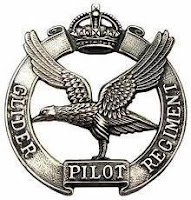 |
| Glider Pilot Regiment Memorial |
The Glider Pilot Regiment was part of the British Airborne Forces from 1914 to 1957.
The British airborne operations capability was set up under the direction of Prime Minister Winston Churchill who was impressed by successful German airborne operations in Belgium in May 1940. The Parachute Regiment was formed on 22 June 1940. The Glider Pilot Regiment was formed 21st December 1941.
 |
| Glider Pilot Regiment formation |
Glider pilots were volunteers from throughout Army and were trained by the RAF. All who qualified as pilots to serve in the Regiment were engaged at the minimum rank of Sergeant.
 |
| Glider Pilot Regiment Pilots |
The gliders were towed into to the landing zone areas by RAF aircraft. Once they were near the landing zone the tow ropes would be released and the gliders would glide to their allocated landing zone.
 |
| Glider under tow |
 |
| Glider Pilots and Troops in Glider |
Once the glider pilots had landed their aircraft on a landing zone they would operate as infantry till they could be recovered for future operations.
 |
| Glider Pilot operating as infantry |
Glider Pilot Regiment Operations
Operation Freshman - 19 November 1942
Landing of commandos to destroy German heavy water production at Vermok in Norway.
 |
| Operation Freshman |
Operation Ladbroke - 9/10 July 1943
Part of Operation Husky, the invasion of Sicily. Landing of troops from the 1st Airborne Division close to the Ponte Grande bridge which they were to capture and hold.
 |
| Operation Ladbroke |
Operation Fustian - 13/14 July 1943
Part of Operation Husky, the invasion of Sicily. This operation was the glider-borne section of a 1st Parachute Brigade assault on the Primosole Bridge.
 |
| Operation Fustian - Primosole Bridge |
For their contribution to Operation Husky the Glider Pilot Regiment were awarded the battle honours;
Landing in Sicily
Sicily 1943
Operation Bunghole - 19 February 1944
Transport of Russian military mission to meet up with Tito and his partisan force.
Operation Tonga - 5/6 June 1944
Initial airborne assault on Normandy as part of Operation Overlord. Operation included coup de main landings at the Caen Canal and River Orne bridges, Benouville. The bridge captured over the Caen Canal would be name Pegasus Bridge. Glider borne troops were also part of the action that captured the Merville Battery.
 |
| Operation Tonga - Gliders ready for Normandy |
 |
| Operation Tonga - Pegasus Bridge |
| Operation Tonga - Normandy |
Operation Mallard - 6 June 1944
Part of Operation Overlord to land an armoured reconnaissance regiment direct to the battle-field. The operation also transported infantry and heavy support weapons.
The Glider Pilot Regiment's contribution to Operation Overlord was recognised with the award of the battle honours;
Normandy Landing
Pegasus Bridge
Merville Battery
Operation Dingson 35A - 5 August 1944
Delivery of thirty-five French SAS soldiers and ten jeeps to join up with French resistance fighters.
Operation Dragoon - 14 August 1944
Airborne element of the invasion of Southern France was carried out by 1st Airborne Task Force (a mix of Allied gliders and paratroops).
For their actions the Glider Pilot Regiment were awarded the battle honour;
Southern France
Market Garden - 17-19 September 1944
Part of the 6th Airborne Division operation to capture the bridge at Arnhem. Transport of 1st Airlanding Brigade.
 |
| Arnhem |
 |
| Arnhem Landing Zone |
.jpg) |
| Arnhem Landing Zone |
 |
| Glider Pilots fighting in Arnhem |
RA Glider Borne Troops
1st Air landing Light Regiment RA
1st Forward Observation Unit (Airborne) RA
1st Air landing Anti-Tank Battery RA
2nd Air landing Anti-Tank Battery RA
The Glider Pilot Regiment were awarded the battle honour;
Arnhem 1944
Operation Manna - 13/14 October 1944
Operation to land troops and equipment at Megara to assist in the liberation and occupation of Athens.
Operation Varsity - 24 March 1945
Part of Operation Plunder, the Anglo-American-Canadian action to cross the northern Rhine River and from there enter Northern Germany. Combined gilder and paratroop airborne operation, largest in history.
 |
| Operation Varsity |
For their part in enabling the crossing of Rhine the Glider Pilot Regiment were awarded the battle honours;
Rhine
North-West Europe campaign of 1944–45
----0----
The actions of the Glider Pilot Regiment during World War Two proved their motto Motto(s) Nihil est Impossibilis. "Nothing is Impossible"
 |
| National Memorial Arboretum Glider Pilot Regiment Memorial Battle Honours |
The Commonwealth War Graves Commission records the names of 477 of the Glider Pilot Regiment who lost their lives during he Second World War.
The Colonel Commandant ot the Glider Pilot Regiment was the notable Gunner Field Marshall Alanbrooke, Chief of the Imperial General Staff (CIGS) during the Second World War, and Churchill's military adviser.
In 1957 the Glider Pilot Regiment was merged with the Air Observation Squadrons of the Royal Artillery into a new unit to form the Army Air Corps (AAC). The need for military gliders was diminished with the introduction of the helicopter which took over the role of inserting units from the air during the 1950's.




